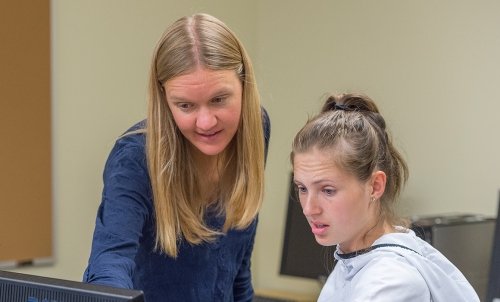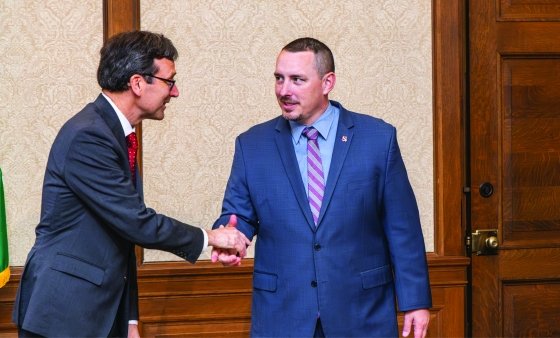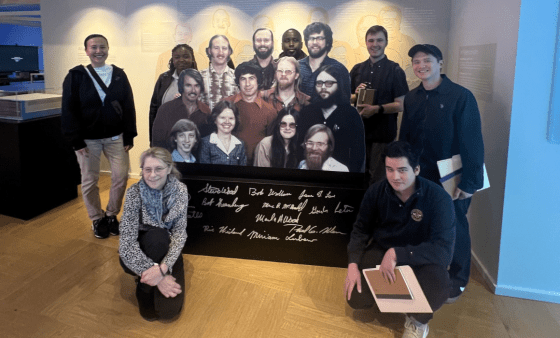Exploring our galaxy

"For the final project in the astrophysics class, the students calculated the motions of pulsating stars as they travel through space."
- Andrea Kunder, Ph.D.
- Physics
- Faculty
Saint Martin's University faculty and students collaborated on research that led to the publication of a paper in The Astronomical Journal.
During the fall semester, Andrea Kunder, Ph.D., assistant professor of physics, Stephen Parker, Ph.D., associate professor of physics, Gordon Bellevue, physics instructor, and Saint Martin’s students Arthur Mills, Joseph Edgecomb, Mathew Thomas, Levi Schilter, and Craig Boyle—all physics minors—collaborated on research that resulted in the publication of a paper, Radial velocities of RR Lyrae stars in and around NGC 6441, in The Astronomical Journal, a prestigious peer-reviewed monthly scientific journal.
Kunder spoke about the research carried out in her upper-level astrophysics class, as well as the group’s results. “For the final project in the astrophysics class, the students calculated the motions of pulsating stars (RR Lyrae stars) as they travel through space. Finding motions of pulsating stars in the center of the galaxy is littered with difficulties — our Earth both rotates on its axis and orbits the sun, our sun orbits the galaxy, and as stars pulsate, they vary their velocities with a specific frequency. The motions of these stars give us an idea of where these stars came from and where they are going, so that we can piece together different parts of our Milky Way galaxy. Our calculations yielded evidence of a smaller system existing in the Milky Way galaxy that is slowly being torn apart by the tidal forces of our massive galaxy. Our galaxy is a massive galaxy, and so its gravity will pull in smaller objects and they will be slowly eaten up.”
“It was great working as a team for something as exciting as an actual research paper,” Mills said about the experience. “Each of us can point to one of the figures that we made within the paper, so it's exciting knowing that other astronomers will be looking at our presentation of data we worked so hard on.”
Thomas echoed Mills’ sentiments. “Co-authoring a paper with other students and faculty members was an enjoyable and profitable experience. Each student took responsibility for their assigned tasks. The group as a whole was willing to work through problems together, assisting and informing each other as needed. Dr. Kunder was the one that pulled the paper together, though. Her expertise and willingness to work with the students made the paper a beneficial experience for us and is the reason that the paper was a success.”
The abstract of the paper is available to read on the Astronomical Journal website, and the full article is available for Saint Martin’s students, faculty, and staff to read through the O’Grady Library’s journal database, and for others to read through the Cornell University Library site.
Kunder will also be working with students this summer as part of a project—funded by a recent grant from the M.J. Murdock Charitable Trust—to study stars that lie at the very center of the Milky Way.
In the image that accompanies the article, the large stars designate the ~12-giga-year-old stars with radial velocities calculated by Saint Martin's astrophysics students in and around the globular cluster NGC 6441. The red symbols designate the stars that were found that are moving with the cluster, and the grey symbols designate the stars that are not. The large number of stars that are outside the extent of the cluster but still moving along its orbit suggest that this globular cluster was once part of a larger system that is being slowly ripped apart by the tidal forces of our massive Milky Way galaxy. This is the first radial velocity study carried out of ~12-giga-year-old stars in and around this globular cluster that covers such a large spatial area on the sky (almost a full degree).
Physics
Physics seeks to explain the workings of the physical world encompassing a vast scale from elementary particles to the cosmos. Physics interacts with fields such as chemistry, biology, astronomy and engineering to provide a background for study in these areas.
- Campus
-
- Main (Lacey)
- Type of Instruction
-
- In Person



